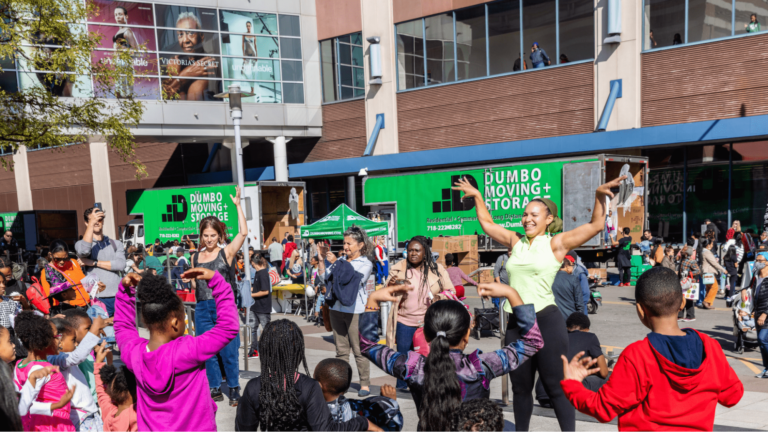Event sponsorships are a huge help when it comes to promoting and financing your event. However, many event creators aren’t familiar with the process of developing relationships with them. So how do you go about finding, contacting, and securing them?
Whether you’re planning a seven-figure festival or a 20-person webinar, the same principles apply. The key to attracting sponsors is creating a valuable offer in return. The more attractive you make this reward, the more sponsors are likely to want to work with you.
In this guide, we’ll walk you through eight steps — straight from our experts at Eventbrite. We’ll show you how to get great event sponsorship for any event.
What is event sponsorship?
Event sponsors pay to support an event in exchange for exposure and branding opportunities. Sponsors seek to align their brand with the event’s audience and objectives.
They may also receive exclusivity in their industry or product category, as well as the right to use the event’s logo and imagery in their marketing.
Sponsors can contribute to a variety of events, including trade shows, conferences, festivals, and sporting events. In return, event organizers work to promote the sponsor’s brand before, during, and after the event through advertising, signage, digital promotion, and other means.
Read on to learn how to secure the best sponsors for your event!

Step 1: Understand why companies sponsor events
What are the benefits of event sponsorship? Sponsorship is a marketing technique that brands use to connect to their customers –- aka your attendees. This means the sponsors you’re seeking have a goal in mind. Ideally, that goal should align with your own event goals.
Access to specific audiences
Events are good at bringing people together who share a common interest. Through sponsorships, brands can tap into a target audience. This is especially useful for advertising to clients a company wouldn’t otherwise reach.
Tradeshow Logic found that the most common reason companies sponsor events is to create sales leads — at the end of the day, revenue is often the most important motivator.
Brand awareness
Event sponsorship allows businesses to advertise their name, products, and services. Like TV ads and billboards, displaying your branding across a festival can generate leads.
Brand credibility
People notice if a business volunteers at a fundraiser or supports community events. Sponsorships increase a company’s corporate social responsibility (CSR).
Shared publicity
You and your sponsors can share mutual benefits by partnering. This can be especially true when partnering with a local business. For example, a local bookstore at a festival attracting thousands provides the experience of a unified community front for all involved.
Recruit new employees or community members
Through sponsorship opportunities, brands can advertise partnering and job opportunities to the public. This reduces the time and money spent on recruiting.
Step 2: Choose the right sponsors for your event
The ideal sponsor will be as excited to work with you as you are to work with them. Sometimes, they’re right around the corner from you; other times, it takes some digging to find them. Use these proven methods to make the search easier:
Identify your audience
To find sponsors that fit your audience, learn about your attendees — their interests, key behaviors, and spending habits. There are several places to start mining this information:
- Your event ticketing platform: Depending on the information attendees provide when registering, you already have a built-in database of demographics.
- Tracking technology: Who’s visiting your website? Technologies like Google Analytics will tell you where they live, what sites they visit, and where they land on your site.
- Social media: If you advertise on Twitter, Facebook, or Instagram, you have access to lots of data. Facebook’s “Audience Insights,” for example, can tell you what pages your target audience has liked and how they spend their money online. Use Eventbrite’s Marketing Platform to make this process more streamlined.

Looking at these various sources of data, you might learn information like this:
- More than half of your target audience likes Amazon’s Facebook page — so Amazon (or one of its competitors) would be a smart sponsor.
- Your followers tend to like winery pages — so a wine shop would be a good fit.
- 70% of those who clicked on your ad live within a single city — so if you want a local sponsor, you should concentrate on a sponsor from that area.
This data is pure gold — it can help you create a razor-sharp pitch for sponsors and create a targeted plan for your event and event marketing.
Find brands that align with your fans
Make a broad list of the types of companies that align with your fans’ expressed interests, and mark them as potential partners.
For example, if your attendees like camping, include outdoor retailers on your list. If they express an interest in luxury travel, spas and resorts should be on the table; if they show an interest in art, local galleries and supply stores will be good options.
Then, get specific. Start making a list of brands you’d like to approach. You might know that you want to woo breweries, for instance — but which ones? One way to filter is by browsing social media to determine which of these breweries would resonate with your attendees. What brands are trending? Does one specialize in gluten-free beer?
Research companies and similar events
Once you have a list of organizations, start digging deeper. Scroll through their socials and check their websites. What topics do they promote? Have they sponsored events before? Add a check to potential leads.
Then, work in reverse. Look up events like yours and find out who sponsored them. There’s a good chance your event will also interest those companies.
Expert example: South Florida Tech Hub
South Florida Tech Hub found excellent sponsors in TriNet and Steven Douglas for their #MiamiTech event. TriNet and Steven Douglas are HR services companies that specialize in serving tech companies.
The tech community and startups that attended #MiamiTech are in perfect alignment with their target audience. That sponsorship may feel obvious to you, and that’s what makes it perfect.

Step 3: Use online tools to find potential sponsors
Contacting successful leads the first time around saves you time and money. Online platforms can help you identify strong potential sponsors. They work as a marketplace for event planners and brands who want to become sponsors.
Pick a platform that fits your style, such as:
- Sponseasy: a user-friendly application for identifying leads and designing esthetic proposals. Use it to pitch, sell, and close sponsorships.
- SponsorMyEvent: used by some of the biggest names in the industry. It facilitates relationships between sponsors and event planners.
- SponsorPark: a strategic marketing consultancy. The platform strengthens partnerships between events and sponsors with a curated touch.
- SponsorPitch: uses analytics to provide data-driven leads at your fingertips. Choose them to identify sponsors and analyze your competition.
- OpenSponsorship: focuses on sports, athletes, and teams — suitable for events or audiences in the sports entertainment category.
Once you have your shortlist of potential sponsors, it’s time to create a pitch.

Step 4: Create an event sponsorship proposal letter
A strong proposal secures sponsors. Your submission should be short, snappy, and supportive of your broader sales pitch. Prepare yours from scratch, or use our templates for event sponsorship emails.
A strong introduction or follow-up in the form of a PDF or PowerPoint presentation can play a pivotal role in your success. These are called sponsorship pitch decks.
Once your pitch is ready, it’s time to reach out to the potential sponsors on your shortlist.

Step 5: Approach key decision-makers to sponsor your event
Not sure how to approach sponsors for an event?
There are many great ways to kick off the relationship. Especially with local business sponsorships, you may already share a mutual friend or have met the person in real life. Strike up a conversation with any relevant contact you have at the company and see if you can get the name of a sponsorship decision-maker.
If you’re starting from scratch, getting to the right person can take time. Don’t give up. Try reaching out through LinkedIn, social media, or the internet’s oldest and most trusted tool: email.
Writing event sponsorship emails is a common practice, but its effectiveness often depends on the quality of your writing. To help you out, we brought in Taylor Price, Creative Strategy Manager and former Content Marketing Manager at Grammarly.
“When it comes to email, words matter,” says Price. “The words you choose need to convince someone that your email is worth opening. And that starts with a good subject line.”
Here are seven cold email event sponsorship guidelines to take note of:
1. Give sponsors a reason to open
As you begin to approach brands for business sponsorship, remember that your goal is not to sell sponsorship. “The average person receives over 120 emails a day,” says Price. “If your subject line asks too much or comes off as needy, it’s likely to end up in the trash.”
Instead, write a subject line that gives the sponsor context for why you’re reaching out to them.
“Imagine you made contact with someone that works for a prospective sponsor at a recent networking event,” Price says. “If you’re convinced they’d remember you favorably, it’s always helpful to bring it up.”
A subject line that says “Met you at [event]. Let’s connect!” sets the context for your message and extends an invitation to continue the relationship. The same strategy works when emailing a referral, too. All you have to do is say, “[Referrer name] recommended I get in touch.”
2. Start off strong
Convincing a prospective sponsor to open your email is just the beginning. Your next challenge is keeping their attention — come off too pushy, and they’ll wonder why they opened it in the first place.
The same applies if you aren’t clear about what you are asking. For example, avoid overused phrases like “hope you’re doing well.”
“It’s a stock opening that we’re all too familiar with,” Price says. “For in-person conversations, it’s socially mandated. But on email, you risk sounding insincere.”
There are better ways to break the ice and get down to business.
“If you’re writing a high-stakes email that needs to get results, it never hurts to do your homework,” says Price. “You don’t have to stalk someone on social media but doing a little research can go a long way. Include a sentence or two at the opening of your email to show you’re familiar with the recipient’s work.”
Let’s say your prospect was recently recognized as an industry leader by a well-respected publication. A brief note congratulating them on their accomplishments shows that you’re interested in their goals.
3. Mention connections
“Again, mentioning a mutual connection is a huge plus,” says Price. “People are much more receptive if you’ve been referred by someone they know and respect.”
While it’s important to give context to your relationship with the sponsor, don’t write a novel. Once you’ve briefly mentioned your mutual connection, transition into the purpose of your email.
Here’s an example: “I recently had lunch with [referrer name], who shared some of your ideas. I was blown away! I think your approach would be a perfect fit for a project I’m working on.”
4. Seek their expert opinion
Remember – sponsorship is supposed to be a win-win. Make your prospective sponsor feel like a resource. “We like to be thought of as experts,” says Price. “We like to know that our opinions matter.”
The key to success, according to Price, is making your request seem effortless. “Keep in mind that you’re not the only person asking for their time,” he says. “If you let them know how long your request will take, they’ll be more likely to respond — and commit.”
You can demonstrate how much you respect their time by keeping your request concise. “Spare 15 minutes to give your expert feedback” is only eight words long and perfectly articulates the request.
5. Ask for the referral or meeting
By now, the potential sponsor should know who you are and what you’re doing. The last piece of the puzzle is telling them what you want them to do. Be explicit and include a clear call to action.
“Would you be able to put me in touch with [referrer name]?” or “Does 3 pm work for a phone call?” are questions that ask them to commit.
6. Bring it to a close
Avoid signing off with “thanks in advance.”
“If you thank a sponsor in advance for doing something, it can come across as arrogant,” Price advises. “Depending on the context, it could make you sound as though you’re expecting them to do something.”
Closing with an expression of gratitude is shown to increase response rates, so while you should avoid thanking your prospects in advance, a simple “thanks” can go a long way.
7. Take the next step
Sponsorship is a relationship business. The better you can build connections with your potential sponsors and establish trust, the more valuable your event will become. Aim to maintain communication without pushing boundaries.

Step 6: Convince companies to sponsor your event
Winning over potential sponsors takes more than mutual connections and a savvy pitch. To get sponsored, you’ll need to prove the value of sponsoring your event and that yours has the best people to pull it off. Here are key pieces of data that will help you secure event sponsorships:
- Attendee demographics: Sponsors want to know if your event attracts their target audience. Go beyond age, gender, and location. Provide education level, job title, and income to determine their purchasing power.
- Non-attendee demographics: Your guests aren’t the only people attending your event. You might have vendors, media coverage, and other sponsors onboard. It’s worth noting who they are and which audiences they reach. This data helps sponsors evaluate the broader brand exposure they will receive.
- Ticket/registration sales: Telling potential sponsors that your event sold out is a powerful indicator that you’re worth partnering with.
- Results generated by previous sponsors: Give sponsor ROI (return on investment) data from previous events you’ve hosted. If you’re planning your first event, do some market research to try and make reasonable projections about your event’s ROI.
- Event mentions: Track when, where, and how often your event is mentioned on social media, websites, blogs, and news sites. The more in demand your event appears, the more attractive a partnership will be.

Step 7: Offer different event sponsorship packages
Use sponsorship packages to give partners a clear idea of how much to offer and what they can expect in return. Tiers help show how the benefits increase with the cost of sponsorship. Many event creators have one main sponsor with exclusive benefits. Event sponsorships can vary from $4,000 to $100,000, but these are some good general ranges, depending on your attendance numbers.
Here’s an example of a three-tier sponsor package:
Gold – $50,000
- Opportunity to address all event attendees in a speaker session
- Brand logo on the cover of all printed event materials and brand profile page
- Main event slide with brand logo and social media handles
- 20 social media posts to promote attendance before the event
- Exhibition stand 18 ft x 18 ft (6m x 6m)
- One-page ad in the event brochure
- Three guest blog posts on the event website
- A key interview in the event podcast
- Website entry
- Sole branding of delegate goodie bags
- The main sponsor of the delegate drinks networking event
Silver – $10,000
- Brand profile page in printed event materials
- Small logo on sponsor page event slides
- 10 social media posts to promote attendance before the event
- Exhibition stand 9 ft x 9 ft (3m x 3m)
- Chance to hold a 30-minute speaker session on a side stage of the event
- Free printed leaflet or program in the delegate goodie bags
- Attendance to delegate drinks networking event
Bronze – $5,000
- Brand profile page in printed event materials
- Small logo on sponsor page of conference slides
- Two social media posts to promote attendance before the event
- Exhibition pop-up stand 6 ft x 6 ft (2m x 2m)
- Attendance to delegate drinks networking event
Some of the other great event sponsorship packages that you could consider are:
- Having one sponsor for each activity or area — for example, specific sessions, talks, or breakout rooms
- Giving restaurant-industry sponsors a vending booth at the event
- Including sponsors in virtual events through branding, speaker sessions, or goodie bag deliveries
Example example: NTICC
The National Transportation in Indian Country Conference (NTICC) did excellent work laying out a wide variety of sponsorship packages. Its guide to sponsorships lays out all the benefits of different sponsorship levels, including a map of the venue and where different sponsors can locate their booths.

Step 8: Thank your sponsors
Make sure your sponsors feel valued. This promotes positive word-of-mouth around your event and lasting relationships.
Here are some methods you could use to thank your sponsors:
Thank them during the event
Give your sponsors the recognition they deserve while the audience is still present. Take a few moments before the end of the event to thank your sponsors and make them feel appreciated. Remember that potential sponsors for future events might take note, too.
Send a thank you note
Send sponsors a handwritten and personalized thank-you note after the event. This shows more effort than an email, and the sponsor can keep it as a memento.
Write a social media shoutout
A social media shoutout helps sponsors feel valued and could send more followers their way. Create an engaging post through videos or photos of them from the event.
Re-share sponsor content
Promoting your sponsor’s content outside of the event agreement shows you’re thinking of long-term partnerships. This could be retweeting a sponsor’s tweet, re-sharing a blog post, or adding their videos to your YouTube channels.
Create a case study
A case study about the sponsor’s involvement in your event improves stats and gives you a reason to stay in touch after the event. Sponsor spotlights can also help entice future partners.
Welcome to a new era of event sponsorship activations
With these tips, you’ll be able to show what added value your sponsors can get from teaming up with you.
And now that you’re familiar with the ins and outs of event sponsorship, are you ready to get your event sponsored? Take advice from event insiders, and create valuable relationships with brands that go beyond funding.
One of the best ways to earn trust from your sponsors is by using trusted, industry-leading tools like Eventbrite. Using Eventbrite lets you market events, create and sell tickets, and analyze event data, maximizing value for your sponsors.






